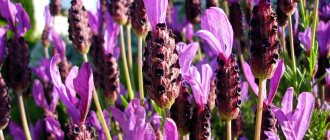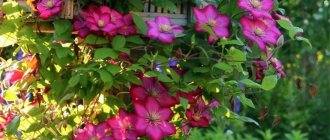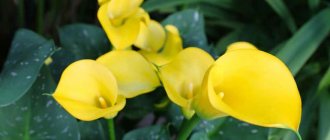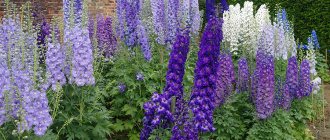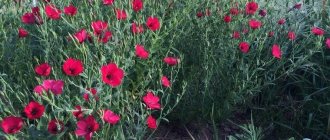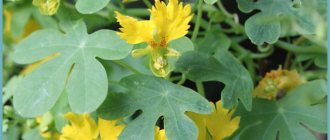The lavender bush (Lavandula) is a member of the Lamiaceae family. This genus includes approximately 30 species. Under natural conditions, it can be found in North and East Africa, Arabia, southern Europe, Australia and India. In each country, only 2 types of lavender are cultivated, namely: medicinal lavender, either narrow-leaved or English, and also French or broad-leaved lavender. The name of the shrub was derived from the Latin word “lava”, which translates as “to wash”; the fact is that in the Ancient world it was used by the Greeks and Romans for washing and washing. Today, lavender can be found not only in the garden; it is also grown on an industrial scale as a valuable essential oil crop.
Brief description of cultivation
- Landing . Seeds for seedlings are sown in February–March, in open ground in October, while seedlings are transplanted into open soil in the last days of May or the first days of June.
- Bloom . It begins in the middle of summer.
- Illumination . Needs plenty of bright sunlight.
- Soil . It should be dry, well permeable to water and air, loamy or sandy with a pH of 6.5–7.5.
- Watering . Lavender must be watered systematically and abundantly. During a prolonged dry period, the frequency of watering is increased.
- Fertilizer . Fertilizing is carried out twice during the growing season. In the spring, a complex mineral fertilizer with a high nitrogen content is applied to the soil, and in the fall, a phosphorus-potassium fertilizer is applied.
- Hilling up . Old plants need to be hilled up twice a season; this is done in spring and autumn.
- Trimming . When the bush fades, all its inflorescences are removed, and in the autumn the branches are shortened. After the plant is 10 years old, it is rejuvenated by cutting off all branches at a height of 50 mm from the ground surface.
- Reproduction . By seed method, as well as by cuttings, layering and dividing the bush.
- Harmful insects . Leafhoppers (slobbering pennies), rainbow beetles and aphids.
- Diseases . Gray rot.
Features of lavender
Lavender is an evergreen perennial shrub whose roots are fibrous and woody and can reach a depth of about 200 centimeters into the soil. It has many stems, reaching a height of about 0.6 m, which become woody in the lower part. The oppositely sessile leaf plates have a linear shape and a greenish-silver color, with soft pubescence on their surface. Fragrant flowers are collected in interrupted spike-shaped inflorescences of 6–10 pieces in whorls; they are colored lilac-blue or blue. Inflorescences are formed in the upper part of leafless shoots. Lavender begins to bloom in mid-summer. This plant is considered an excellent honey plant. If its seed material is stored correctly, then it will have excellent germination even after many years. This shrub is considered a relative of the following crops: hyssop, basil, mint, lemon balm, motherwort, oregano, sage and rosemary.
LAVENDER - cultivation, care, planting, watering, reproduction, flowering, features
Choosing a place to plant lavender
Wild lavender grows in mountainous and hilly areas, and prefers those areas where there is a lot of rainfall. Industrial cultivation of lavender geographically coincides with viticulture zones: France, Italy, Moldova, Crimea, North Caucasus. The soils on which this subshrub grows are infertile, slate or carbonate.
Important: lavender does not tolerate close groundwater or stagnation of water during heavy rains or melting snow in the spring. Therefore, when planting, you need to choose a high place and ensure good drainage.
Growing lavender from seeds
Planting in open ground
Lavender seeds can be sown directly in open ground before winter, or more precisely in October. If you grow it through seedlings, then the seedlings are planted in the garden in the last days of May. If you decide to grow such a shrub from seeds, then you need to purchase them in advance, or rather, in the first weeks of winter or early autumn. The fact is that before you start sowing the seeds, they need to be prepared. To do this, the seed material is stratified for two months at a temperature of about 5 degrees, which significantly increases its germination. To do this, the seeds must be combined with moistened sand and placed on the refrigerator shelf intended for vegetables. Sowing seeds for seedlings is carried out in February–March.
Sowing seedlings
The container intended for sowing lavender must be filled with a pre-prepared substrate, which should include coarse river sand and humus (1:2). Since the seeds of such a plant are very small, the finished soil mixture should be sifted, which will help remove all lumps from it. Then the substrate is disinfected, for this it is spilled with a rich pink solution of potassium permanganate or calcined in the oven at a temperature of 110 to 130 degrees. A drainage layer is first laid at the bottom of the box, which has holes for drainage, after which it is filled with the prepared substrate.
Stratified seed material is evenly distributed over the surface of the soil mixture, after which it is sprinkled with a three-millimeter layer of sand. Moisten the crops with warm water from a spray bottle and cover them on top with transparent film or glass. Place the box in a warm and well-lit place. Crops need systematic ventilation; for this, every day you need to briefly raise the shelter. In order for seedlings to appear, crops must be at a temperature of 15 to 22 degrees.
Seedling care
Immediately after the seedlings appear, they need to be regularly illuminated, otherwise they will stretch out very quickly. The plant must be accustomed to new growth conditions gradually. To do this, you need to remove the shelter for a while every day, and the duration of the procedure should be increased gradually. Immediately after the seedlings get used to the new growing conditions, the shelter can be removed altogether. After this, the lavender must be planted in a larger box so that the distance between the bushes is at least 50 mm.
Growing LAVENDER seedlings from seeds
Planting in open ground
Seedlings are planted in open soil in the last days of May. Often this shrub is used to decorate alpine slides, to create borders, or it is planted on both sides of paths. The culture grows well in open sunny areas. Since lavender reacts extremely negatively to excess moisture, it is not recommended to choose an area with a high level of groundwater or wetlands for planting it. Dry sandy loam soil is perfect for growing it, but it also grows quite well in well-drained loamy soil. The recommended pH of the soil on the site is 6.5–7.5. If the soil is acidic, then crushed limestone should be added to it.
Before planting, the area should be thoroughly prepared. To do this, it is dug up to a depth of at least 0.2 m, and then the soil is well loosened, for this purpose compost or peat is added to it.
When planting seedlings of vigorous varieties, a distance of about 1.2 meters is maintained between the bushes. When planting seedlings of other varieties, the distance between plants should be from 0.8 to 0.9 meters. The planting hole is made so deep that the bush’s root system can fit into it. Before planting the seedling, its roots need to be trimmed a little, after which the bush is placed in a hole and covered with earth. After planting, the root collar should be buried 40–60 mm into the ground. Planted seedlings need abundant watering.
Pre-winter sowing
In regions with a mild climate and warm winters, it is recommended to sow seeds directly into open ground. Sowing is carried out in October in a previously prepared area. To do this, they dig it up and at the same time add peat to the soil. If the soil is excessively wet, this can be corrected by adding sand or fine gravel to it, which will increase its drainage properties. The seeds are buried 30–40 mm into the soil, after which the surface is slightly compacted. If the autumn turns out to be dry, the crops are watered moderately. When the first snow falls, they should cover the surface of the area so that the result is not a very large snowdrift.
Sowing Lavender before winter
Location and care.
Lavender is a light-loving and drought-resistant plant, heat-loving, although it can withstand frosts of 18-200 C.
Open sunny areas are suitable for growing lavender This will allow you to achieve abundant and long-lasting flowering. In partial shade, lavender will be able to grow, but the bushes will be looser and not as attractive. When planting, maintain a distance between bushes of 30-40 cm. Adult plants do not tolerate replanting well. If, nevertheless, there is a need to move the bush to another place, then you need to dig it out carefully, with a large lump of earth.
Lavender roots are sensitive to high levels of moisture in the soil, so wetlands and those with high groundwater levels are unsuitable for growing lavender.
Caring for lavender in the garden
After the first inflorescences form on the lavender seedlings, it is recommended to tear them off. Thus, young bushes will not waste their energy on forming flowers, but will be able to grow stronger and form a powerful root system. After planting lavender in the garden, during the first season it grows extremely slowly; therefore, you need to regularly pull out weeds, as they can choke out young shrubs.
In addition, the bushes will need to be systematically pruned and also fed. At the same time, it is recommended to use potassium fertilizers for fertilizing. The fact is that nitrogen fertilizers and manure promote the active growth of green mass, and this negatively affects flowering.
Watering and hilling
In order for lavender to grow and develop well, it needs abundant, systematic watering. On hot days, the frequency of watering is significantly increased. Every time after it rains or waters, loosen the surface of the soil between the plants and remove all weeds. In order to significantly reduce the amount of weeding, loosening and watering immediately after the seedlings are planted in open soil, the surface of the earth between them is covered with a layer of mulch (peat).
Old shrubs always mount high in spring and autumn. Thanks to this, new shoots will be able to form on old branches.
Trimming
This shrub requires systematic pruning, which is carried out every year. Immediately after the bush has faded, the inflorescences that have begun to fade are cut off, and in the autumn the branches are shortened to give the lavender a neat shape. Make sure that it does not stretch too far upward, as powerful gusts of wind can cause the bush to fall over, as a result of which it will lose its decorative effect. After the age of the plant is 10 years or more, if necessary, anti-aging pruning can be carried out; for this, all branches are cut off, leaving only sections about 50 mm long. This type of pruning can also be done on younger shrubs if they bloom very sparingly.
Autumn pruning of lavender
Advantages and disadvantages
Among the advantages of growing lavender in an open area in the garden are:
- easy care;
- unpretentiousness of the plant;
- decoration of the area and natural aromatization of the surrounding air;
- thanks to the huge variety of varieties, with lavender you can create not only ordinary flower beds, but also alpine slides, rockeries, decorate borders, and form hedges;
- the plant is an excellent honey plant, so beekeepers often plant it on their site.
Among the disadvantages:
- low germination of seeds planted directly into the ground;
- in cold regions, even frost-resistant varieties should be additionally covered;
- mature bushes do not tolerate transplantation to a new location.
Reproduction methods
Lavender can be grown from seeds, and also propagated by layering, dividing the bush and cuttings. How to grow it from seeds is described in great detail above.
Propagation by cuttings
This propagation method is suitable for those who already have lavender on their site or have the opportunity to get its lignified annual shoot. The stem is cut into lengths from 80 to 100 mm. The resulting cuttings are planted for rooting in a loose, moistened substrate, while their lower cut is buried by approximately 20–30 mm. They are covered with transparent glass jars on top. It will be possible to remove the shelter only after the roots of the cuttings grow.
Dividing the bush
To propagate the crop, the method of dividing the bush is also used. However, the plant should be prepared for this procedure. Select a mature, overgrown shrub. With the onset of autumn, when it fades, it should be pruned to a height of about 10 centimeters, after which it is hilled high, trying to fill the entire space between the stems with soil. In spring, the plant is hilled again. Throughout the summer, the bush produces abundant growth.
With the onset of autumn, the bush is removed from the ground and divided into several parts with well-developed roots and stems. Next, the divisions are planted in a new place in separate holes.
Reproduction and planting of lavender
Reproduction by layering
To propagate the shrub by layering, in spring you should select several stems, bend them and place them in grooves 30 to 40 mm deep, made in the soil near the plant. Fix the shoots in this position, cover them with soil and water well. During the summer period, make sure that the soil above the layering is always slightly moist. It is possible to separate the cuttings that have given roots from the bush only with the onset of the next spring. Next, the cuttings are dug up and planted in a permanent place.
Rules for transferring from one place to another
Mature lavender bushes have difficulty transplanting from one place to another . If you cannot do without this, then before digging the plant you need to water it abundantly so that digging it out of the ground is less painful for it.
Dig up an adult lavender along with a lump of earth so that trauma to the roots is minimal.
When digging, damage to the roots is inevitable , therefore, they should be dipped in the following solution: for 10 liters of water - 1 bag of roots, 1 kg of manure, 1 tablet.
Heteroauxin and some clay. When the solution on the roots of the plant dries, plant the bush in a new place, prepared according to all the rules. How to properly transplant lavender to another place is described here.
Pests and diseases of lavender
When grown in open soil, lavender is very resistant to harmful insects and diseases. However, problems can arise with it too. In some cases, the bush is affected by gray rot, or rainbow beetles or slobbering pennies (leafhoppers) settle on it.
If pests have settled on the bush, you can get rid of them by collecting insects manually. Then be sure to replace the mulching layer under the bush. The development of gray rot is facilitated by regular stagnation of liquid in the soil, which can be caused by excessively frequent and very heavy watering or prolonged rains. This disease cannot be treated, so it is recommended to dig up and destroy the affected bush. If the disease is at the initial stage of development, then you can try to save the lavender; to do this, immediately after detection, all affected parts of the bush are cut out. And then the watering regime must be adjusted.
Why is it important to be able to distinguish and choose correctly?
In order to choose the right variety to grow on your site, it is important to understand for what purpose it is needed . If for decoration and creating decor, then preference is given to compact varieties with beautiful shades. If this is a region with a cold climate, then in addition to the decorative appearance, you should also pay attention to the plant’s ability to tolerate frost.
When growing lavender for the purpose of obtaining medicinal raw materials, forming dry aromatic bouquets or sachets, then you need to opt for medicinal varieties with a rich aroma, as well as those that are able to retain their aroma and attractive appearance after drying.
Growing in the Moscow region and Moscow
Lavender angustifolia (medicinal or English) grows best in Moscow and the Moscow region. It is necessary to plant it in the ground and care for it in average conditions in the same way and almost at the same time as in warmer regions. Sowing seeds directly into open soil is carried out from mid to late May, immediately after return frosts are left behind. Seedlings are planted in open ground in the first days of June. It is not recommended to sow seeds before winter, because there is a high probability that they will freeze.
Features and description of the plant
Lavender is 47 species of perennial plants of the genus Lavender of the Lamiaceae family. People have developed several hybrids of the bush, and 47 natural varieties grow in Europe, India, Australia, northern and eastern Africa, the Canary Islands and the Arabian Peninsula. The plant has taken root on mountain slopes and plains: in temperate, subtropical and tropical climates. Easily tolerates exposure to scorching sun and lack of moisture. Mostly cultivated varieties are grown in gardens. During the ripening period, the bushes are covered with flowers of violet, purple and lilac shades. Lavender is used to improve the smell of clothes, and one of the leading chains of dry cleaners and laundries was even named after this flower. The plant is also used in perfumery, also due to its aromatic properties. The leaves and flowers are used to make tea, and in some European countries, ice cream.
Known species:
- lavender angustifolia;
- toothed;
- stehadskaya.
Types and varieties of lavender with photos and names
Today, gardeners cultivate only broadleaf and angustifolia lavender. Below we will also describe those types of lavender that can also be grown in your garden.
French lavender (Lavandula stoechas)
Or broadleaf lavender (Lavandula latifolia). The homeland of this species is South-West Europe. The scent of the spectacular lavender flowers is very strong; they can be colored in various shades of pink, green, white, purple, lilac or burgundy. This lavender blooms somewhat earlier than other types, and this happens in April–May. Flowering ends in July, but sometimes in the last summer weeks the bush blooms again. Compared to narrow-leaved lavender, this species is not as frost-resistant; therefore, it is cultivated mainly in regions with warm and mild climates. The most popular variety among gardeners is Lavandula stoechas pedunculata, or “butterfly” (Papillon): the flowers of this shrub have an unusual, spectacular shape. The best varieties of lavender are:
- Yellow Vale . The foliage of the shrub is greenish-yellow, the flowers are dark purple, and the bracts are crimson.
- Regal Splendur . The flowers are dark purple.
- Rocky Road . This variety appeared relatively recently. Its large, bluish-purple flowers open in July.
- Tiara . The bracts of the large blue flowers are cream colored.
- Helmsdale . The flowers are burgundy-lilac.
Lavender hybrid (Dutch)
This group of highly decorative hybrids was created using English lavender and other species of the genus. Such a large shrub is decorated with narrow silvery leaf plates, as well as large oblong flowers located on long peduncles that bend under their weight. It blooms in July. The best varieties include:
- Alba . The flowers are painted white.
- Arabian Knight . The color of the flowers is dark purple or dark blue.
- Sawyers . The color of the flowers is pale lilac.
- Grosso . Large beautiful flowers are colored lilac-violet.
- Richard Gray . The compact bush is decorated with dark purple flowers.
Toothed lavender (Lavandula dentata)
This species is native to the Mediterranean. It is a compact shrub that is thermophilic. The silvery leaf plates are rugged and soft. Flowering occurs in July, during which large fragrant flowers open. The species is not highly resistant to frost. The most popular variety among gardeners is Royal Crown: the flowers are purple.
Lavender angustifolia (Lavandula angustifolia)
Either English lavender (Lavandula spicata) or medicinal lavender (Lavandula officinalis). This shrub is native to Southern Europe. This perennial is decorated with greenish-silver foliage and small lilac-blue flowers. Flowering begins in July–August. This species differs from others in that it has the highest resistance to frost. The most popular variety of this shrub is delphinium lavender: the height of the bush is no more than 0.3 m, it is decorated with very impressive silver-colored leaves. Hidcoat lavender is also widely cultivated, most often it is used to create not very high hedges. The best varieties include:
- Alba . Half-meter bushes are decorated with white flowers.
- Rosea . A low shrub, reaching a height of about 0.4 meters, forms mauve inflorescences during flowering.
- Manstead . Bright blue flowers bloom on a bush that reaches a height of 0.4 meters.
- Hidcoat Giant . The height of such a compact shrub is approximately 0.6 m.
- Hidcoat Blue . Purple-blue flowers adorn the compact plant, which reaches a height of about 0.4 m.
Lavender rules
Is it possible to grow lavender on the balcony?
Experienced flower growers say - quite.
To do this, you should select dwarf varieties of angustifolia lavender with a small root system and plant them in stable, tall ceramic containers, placing them directly on the floor of the balcony or securely fastening them to its edge.
Fill the pots with sandy loam and water occasionally, drying the earthen ball well.
Additional care should be taken about wintering, covering it well if the balcony is not glazed.
Properties of lavender: harm and benefits
The healing properties of lavender
Lavender contains essential oil in all aerial parts; it contains linalool, coumarins, ursolic acid, tannins, geraniol and borneol. Lavender oil is very useful, due to this it is widely used both in medicine and in the perfumery and cosmetics industry. This oil is used in the treatment of bruises and burns. Lavender is also used in the treatment of cerebrovascular diseases, seizures and paralysis after a stroke, and it can also help with dizziness, headaches and drowsiness. The culture has a diuretic effect, and it can also eliminate toothache. Tea with this plant is used to relieve discomfort and stomach cramps. It can also help with melancholy, irritability, hysteria and neurasthenia, as well as with influenza, asthma, bronchitis, whooping cough, tuberculosis, enteritis, flatulence, atony of the gastrointestinal tract, worms, rheumatism, cystitis, amenorrhea, hypertension, fever and various rashes .
Experts note that lavender infusion has a positive effect on the human nervous system as a whole, as well as on his general mental state. It helps eliminate stress, as well as reduce the negative impact of adverse factors on a person’s mental state and consciousness. It was also noted that the infusion helps stimulate mental activity and quickly restore energy and strength. Lavender foliage is used to prepare healing baths, and dried inflorescences are used as an effective anti-moth remedy when storing clothes, and also as a fragrance for linen and rooms.
This TEA for STRESS, HEADACHES, for the HEART, improves MEMORY...
Contraindications
Lavender oil should not be used by pregnant women, especially in the early stages, because lavender helps stimulate contraction of the uterine muscles. It is also prohibited to use it after an abortion, since in this case it can cause bleeding. Lavender should not be used simultaneously with medications that contain iodine or iron. Long-term use of oil can cause the development of depression, as well as irritation of the gastrointestinal mucosa. Lavender-based products have a powerful effect, and therefore can cause a severe allergic reaction. In this regard, before using such a drug for the first time, you must consult with a qualified specialist.
Lavender as a perennial garden crop
Lavender looks great in tandem with climbing plants
Despite the fact that lavender came down to us from the dry mountain slopes of the western Mediterranean, growing it in the garden or in the country is not difficult, and this process brings great pleasure. The plant is heat-loving and prefers the southern regions, but it can be grown both in the Moscow region and in the Leningrad region, and if you have a strong desire and a certain skill - even in the Urals and Siberia.
Lavender prefers sunny and warm corners, although it can grow in partial shade. For care, it requires abundant but not excessive watering, good drainage, periodic hilling, fertilizing, obligatory “haircut” after flowering and shelter or mulching for the winter.
